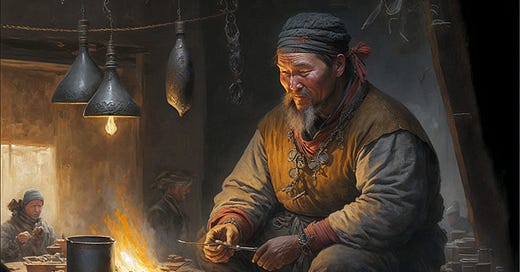Thanks for bearing with me while I went radio silent in December! I found out I was pregnant over Thanksgiving break, had some complications that led to me taking an unexpected leave of absence from work (which involved a lot of logistics and paperwork), and got very sick with one of those respiratory colds that are going around. I'm still digging out from the holidays, but things should be back to normal for now.
Quick Facts
Although they didn’t use horseshoes on the feet of the hundreds of thousands of horses their warriors rode on, the Mongols were accomplished blacksmiths by the time they built their great empire in the thirteenth century. In fact Genghis Khan’s name early in life was Temujin, meaning ‘blacksmith’.
Mongolian blacksmiths weren’t the only nomadic smiths; 19th century tinkers travelled from town to town fixing broken tinware like lanterns, dinnerware, baking pans, and chandeliers. All they needed was skill, some handheld tools, a soldering iron and a light anvil.
During the Middle Ages blacksmithing was one of the seven artes mechaniae (mechanical arts) which were considered integral to society, along with agricultural work, cooking, tailoring, masonry, the martial arts and trade. While the art of the smithy was decimated by the Industrial Revolution and the rise of twentieth-century mass production, today blacksmiths are back in demand as the market for all things artisanal and handmade makes a comeback.
Early Native Americans were among the first people in the world to mine metal and fashion it into tools. Although early blacksmithing tends to be associated with the ‘Old World,’ copper is plentiful and pure near the Great Lakes – but after using copper tools for a few thousand years, the practice seems to have stopped abruptly and people went back to using stone and bone, which is just fine for most purposes… only copper awls are distinctly superior.
Contrary to cinematic portrayals of Medieval towns tending to have a single smithy to service a town filled with diverse artisans in support of the surrounding farms, post-iron economies in West Africa tended to see specialization at the village level, i.e. a village of smelters and smiths, a village of leatherworkers, a village of potters, etc.
The Dark Smith of Drontheim
Siebold Adelbertsmiter, also known as the Dark Smith of Drontheim, is a delightful secondary character in the Mercy Thompson series by Patricia Briggs. In ‘real’ life, his name was Loan Maclibuin and he hailed from Trondheim in northern Norway. Known as the Dark Smith because of complexion, which was unusual for that part of the world, his story is related in the Manx folk tale Olave Goddardson and the Sword Macabuin. Legend has it that the Manx Sword of State is the legendary Maclibuin forged by the Dark Smith.
The tale is actually set on the Isle of Man, where King Olave, who was of Norwegian descent, was in possession of the sword Maclibuin. It was rumoured that Maclibuin could cut through the hardest granite with ease, such was its power. When the Dark Smith learns that Olave intends to execute a low-born subject with the sword he gets angry. Unfortunately, Olave ends up travelling to Drontheim, where he slays the smith and takes Maclibuin's daughter Emergaid to the Isle of Man – where they are married.
The Auschwitz Sign
A sign reading Arbeit macht frei, meaning ‘Work sets you free,’ was installed over the gate of Auschwitz concentration camp during the Second World War. It was crafted by a prisoner of the camp, Jan Liwacz, a Polish master blacksmith who was arrested in 1939 for burning an effigy of Adolf Hitler. When the Nazis learned he was a blacksmith they ordered him to make the sign, but in a subtle act of defiance Liwacz welded the ‘b’ in Arbeit upside down. Liwacz spent several stints in solitary confinement at Auschwitz, but he did survive the war and went on to work as a blacksmith for many years after the war.
Bruno Ferrin’s Wonderland
Bruno Ferrin is an Italian restaurant owner. For the past 50 years, he’s been building his own amusement park in the woods near his restaurant. In the course of doing so, Ferrin became a self-taught blacksmith as he moulded loop-the-loops, slides, trampolines and his very own original rides out of recycled metal and materials. For years Ferrin assembled his wonderland as a personal hobby, but today the amusement park has become a hotspot for German, Austrian and Italian tourists looking to see what an ecological amusement park built by one smith looks like.
Armourer of Emperors
Lorenz Helmschmied, scion of famous blacksmiths – their name means “helm smith” – was one of the most skilled armorers of the late 15th century; he became a royal armorer the same year he became a master blacksmith – 1477. By the 1480s he was the official armourer to Frederick III, the Holy Roman Emperor and head of the Austrian House of Habsburg, a role which he later performed for his son and heir, Emperor Maximilian I. He served as an armorer during military campaigns in the Netherlands, as well. Examples of Helmschmied’s armour, inlaid with gold and silver and crafted with skill and, more importantly, innovative design, are on display in the Kunthistorisches Museum in Vienna, Austria and the Detroit Institute of Arts.
📗 If you found this interesting, you may also enjoy my previous newsletters about unique Etruscan jewelry smithing techniques & how waterwheels helped ancient smiths forge using huge hammers.
💚 If you learned something from this overview, consider forwarding it to a friend and encouraging them to sign up for more overviews of my research into obscure history and science.
⚒️ Do you have a favorite story about ancient smiths? Please reach out — I'd love to hear about it, either via email or in a comment where other readers can see.



